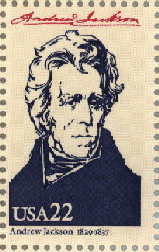Andrew Jackson 1767-1845 A brief biography
Road to the Presidency - Part II, The Jackson Coalition 1825-1828
 In the years 1825-1828, a strong coalition arose to throw Adams and Clay
out of office. After Jackson's huge plurality, he was the obvious candidate
of those who wanted to limit Federal power.
In the years 1825-1828, a strong coalition arose to throw Adams and Clay
out of office. After Jackson's huge plurality, he was the obvious candidate
of those who wanted to limit Federal power.
One member of this anti Adams coalition was the Vice President, John C. Calhoun. He wrote an acquaintance in 1826 that the Adams Administration "because of the way it came to power ... must be defeated at all hazards, regardless of its measures"(Margaret Coit Andrew Jackson p.160).
Another faction moving into coalition with Jackson were the 'Radicals' or 'Old Republicans', who were rigidly opposed to centralized government. William Crawford their one-time leader, was in poor health.
Martin Van Buren of New York State, a kind of political manager for the Radicals, quickly formed a strong respect for Jackson, and helped forge the link between his group, and Calhoun and Jackson. Van Buren also favored the creation of strong contending political parties, and became one of the principal architects of the Democratic Party.
Adams hurt his cause in his first State of the Union address. Drawing up an ambitious program of internal improvements, he said he hoped Congress would not give the world the impression "that we are palsied by the will of our constituents". Many felt this went to the heart of Adam's disregard for the will of the electorate.
Senator John Randolph gave voice to the idea of an 'unholy alliance' between Adams and Clay when he spoke of them as the "Puritan and the Black-leg" (referring to two characters in Tom Jones). Adams was a descendant of New England Puritans, and preserved some of their stiff social ideas. This made Clay the "blackleg" or crooked gambler. Clay challenged Randolph to a duel in which Randolph fired in the air, and Clay may or may not have tried to hit Randolph. They parted cordially, having played their roles as Southern "gentlemen".
